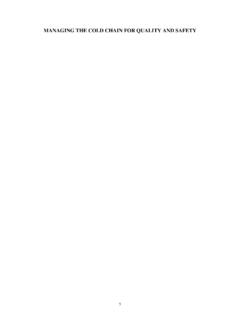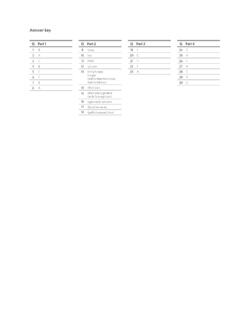Transcription of The Basic Methods of Pearl Farming: A Layman’s Manual
1 CTSA Publication No. 127. The Basic Methods of Pearl farming : A Layman's Manual Maria Haws The basics of Pearl farming : A Layman's Manual Maria Haws, Director Pearl Research and Training Program Pacific Aquaculture and Coastal Resources Center University of Hawaii at Hilo Hilo, HI 96720 USA. Center for Tropical and Subtropical Aquaculture Publication No. 127. March 2002. Table of Contents Table of Contents Acknowledgments .. 1. Introduction .. 3. A short history of Pearl culture .. 5. Benefits of Pearl culture .. 7. Basic biology and ecology of Pearl oysters .. 9. Overview of Pearl farming .. 13. Determining if Pearl farming is possible and will be profitable for you .. 15. Selecting a site for a Pearl oyster farm .. 21. How to setup the farm .. 23. Preparing the Pearl oysters for hanging on the farm .. 29. Guidelines for keeping Pearl oysters on chaplets or in containers .. 31. General farm management .. 33. Handling and transport .. 35.
2 Spat collection .. 39. Disease and other causes of death .. 47. Nucleus implantation (grafting) .. 51. i Basic Methods of Pearl farming 57. Half- Pearl (mabe) implantation .. 59. Selling pearls and Pearl products .. 63. Appendix .. 67. Glossary .. 73. Suppliers of aquaculture and Pearl farming supplies .. 75. 79. ii Acknowledgments Acknowledgments The assistance and knowledge of many Pearl farmers, colleagues and fellow researchers is gratefully acknowledged. Among those who selflessly contributed to this effort to provide the Basic information needed by farmers to start Pearl farms and produce high quality pearls are: Jean and Estelle Tapu, Tyrone Tapu, Ron Hall, Taruia Matara, Tarani and Piltz Napa, Soa Tini, Simon Ellis, Anne Orcutt Bailey, Kevan Main, Ben Ponia, Miles Anderson, Quentin Fong, David Thompson, Joan Rolls, John Rowntree, Tap Pryor, Kennedy Paynter, Francis Thibodeau, Fred Ward, Timothy Dick, Kelvin and Anna Passfield and John Sprague.
3 Several private companies also contributed to this effort: Tapu Perles, Nukuoro Pearl farm , Robert Reimers Enterprises and Black Pearls of Miconesia. Special thanks go to my colleagues of the Coastal Resources Center of the University of Rhode Island, who provided the moral support and flexibility to allow this Manual to be written. Dr. Cheshire of the Pacific Business Program, University of Hawaii at Manoa, kindly provided assistance with the economic as- pects of this work. The support given by CTSA and its personnel, Dr. Cheng-Sheng Lee (Director), Simon Ellis (Regional Aquaculture Extension Agent) and Kai Lee Awaya is greatly appreciated. Illustrations and photographs were prepared by Diane Nakashima, Oscar Blanco and Maria Haws. The author is particularly grateful to Diane Nakashima for her efforts with the illustrations and for prepar- ing the cover. Cover photographs are courtesy of University of Hawaii Sea Grant. Above all, this work was inspired by the Pearl farmers of Penrhyn (Tongareva), Cook Islands, who worked to establish Pearl farms while maintaining the environmental health of their lagoon.
4 Funding for the printing of this publication was provided by the Center for Tropical and Subtropical Aquaculture (CTSA) through a grant from the Cooperative State Research, Education, and Extension Service of the Department of Agriculture (Grant #98-39500-5947). This publication was pre- pared with support from a grant from the Pacific Aquaculture Development Program, University of Hawaii Sea Grant Program,under Institutional Grant No. NA86RG0041from the National Oceanic and Atmospheric Administration (NOAA) Office of Sea Grant, Department of Commerce. UNIHI- SEAGRANT-grant # GEN 103. The views expressed herein are those of the author and do not necessarily reflect the views of the Department of Agriculture, CTSA, University of Hawaii Sea Grant, NOAA or any of their sub-agen- cies. Funding and resources were also provided by the following companies: Tapu Perles and SeaPearls. Page 1. Basic Methods of Pearl farming Page 2. Introduction Introduction The purpose of this Manual is to provide a reliable source of Basic information for beginning Pearl farmers to help them successfully start farms and produce high quality pearls.
5 The Manual is formatted so that each individual section can usually standalone and therefore if read from cover-to-cover, there will be some repetition. As this was written and published in the United States, all references to money are made in dollars. Because most Pearl farmers hope to avoid competition by keeping their Methods secret, the Pearl farm - ing industry has traditionally been one of the most problematic of aquaculture businesses to start from scratch. Although the Basic Methods are simple, beginning Pearl farmers find it difficult to obtain the technical information needed to learn how to operate a farm , thus generally spending a long period of time experimenting. This Manual describes Basic Methods of Pearl culture that are used on small- to medium-sized Pearl farms throughout the Pacific. By using the proven Methods described in this Manual , the new farmer should be able to immediately start and operate his or her Pearl farm .
6 Page 3. Basic Methods of Pearl farming Page 4. A short history of Pearl culture A short history of Pearl culture Pearls were the first gems discovered by man thousands of years ago. Since that time, people of many cultures have recognized the beauty and value of pearls. Pearls are the only organic gems and require no processing to reveal their natural beauty. At first, people relied on the chance finding of natural pearls in a variety of species of marine bivalves and freshwater mussels. Natural pearls are rare as perhaps maybe 1 in 2,000 Pearl oysters contain a natural Pearl . Natural pearls are formed when the Pearl oyster reacts to an irritant by coating it with nacre, the shiny iridescent material found on the inner surface of the shell. Natural pearls are usually small, of various colors and irregular in shape. The high value of natural pearls led to the creation of Pearl fisheries in nearly every part of the world where Pearl - producing mollusks were found.
7 Most of these Pearl fisheries were short-lived because the fishers soon over-exploited the natural stocks. Prompted by the high value and scarcity of natural pearls, Japanese researchers developed Methods that brought Pearl production under the control of humans in the early twentieth century. These cultured pearls . are generally larger and of a more consistent size and color than natural pearls. Producing cultured pearls depends on a surgical procedure called grafting, which entails surgically implanting an artificial nucleus (shell bead) into the tissue of a Pearl oyster. The oyster then secretes nacre around the nucleus. After several years of caring for the oysters, the cul- tured pearls are harvested. Figure 1. Black-Lip Pearl oyster in its natural habitat, a coral reef of the Cook Islands. (photograph: Maria Haws). Several species of Pearl oysters are cultivated for Pearl production. This Manual focuses on the Black-Lip Pearl oyster (Pinctada margaritifera).
8 Black-Lip Pearl oys- ters are the most common species of Pearl oyster found in the South Pacific islands (Figure 1). The Black-Lip Pearl oyster is distinguished from other species by the dark, iridescent nacre found on the inner shell. Pearls produced by Black-Lip Pearl oysters are known as black pearls or Tahitian black pearls (Figure 2). Figure 2. Black pearls resting on the shell of a Black pearls are large, usually over 7 mm ( in) in Black-lip Pearl oyster (Pinctada margaritifera). diameter and may be as large as 22 mm ( in). Note: (photograph: Maria Haws) Pearls are always measured in millimeters within the Page 5. Basic Methods of Pearl farming industry. The nacre and pearls of Black-Lip Pearl oysters are generally black or gray with shades of blue, green, silver and pink. Most black pearls are produced in the sheltered waters of the atolls of French Polynesia and the Cook Islands, although Australia, Indonesia, the Philippines and the Western Pacific Islands have growing black Pearl industries.
9 Page 6. Benefits of Pearl culture Benefits of Pearl culture Pearl farming is an attractive business venture because of the high value of the final product. Although black pearls vary greatly in value depending on the size and quality, large, round pearls of high quality can sell for very high prices. For example, farm prices (2000) showed an 8-mm ( in) black Pearl rated good sells for around $40 while a 12 mm ( in) Pearl of the same quality sells for up to $120. In recent years, Pearl prices have fallen signficantly, especially for smaller, lower-quality pearls. The price of large and high quality pearls, however, have not declined as rapidly. One of the principal advantages of Pearl production is that the final product is lightweight and non- perishable. Pearl oysters are most commonly found in remote tropical atolls where commercial exploi- tation of marine resources such as fish is difficult due to the lack of refrigeration and shipping facilities.
10 Pearls require no refrigeration and very simple processing. Pearl farming is also a compatible occupa- tion for people who like working on the water and have boating, diving and fishing skills. With the exception of the grafting process, Pearl farming is a relatively simple form of aquaculture because Pearl oysters do not require artificial feeds, complicated farm structures or constant attention. If properly managed, Pearl farming will not harm the environment and can increase the wild Pearl oyster population over a period of years. For these reasons, Pearl culture may be the best opportunity for business development in many isolated island areas. Three cautions Although pearls are a high value product, many Pearl farmers fail in their attempts to make a living by Pearl farming . When considering Pearl farming as an investment opportunity or as a small business, there are three key points to remember: 1) Successful Pearl farming requires a long-term investment of time, money and hard work.











